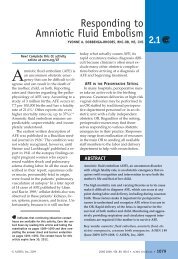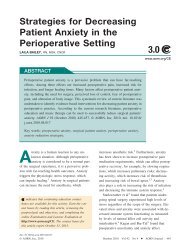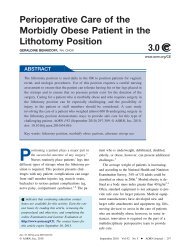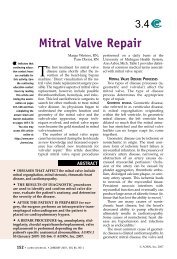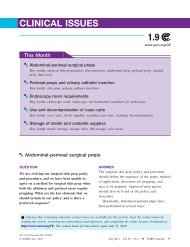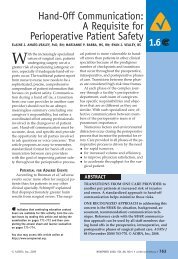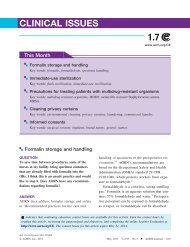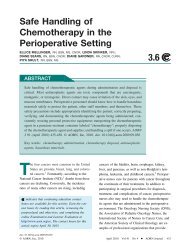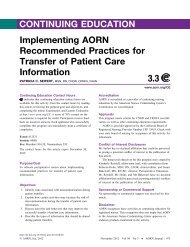Perioperative Care of the Patient with Bipolar Disorder ... - AORN
Perioperative Care of the Patient with Bipolar Disorder ... - AORN
Perioperative Care of the Patient with Bipolar Disorder ... - AORN
You also want an ePaper? Increase the reach of your titles
YUMPU automatically turns print PDFs into web optimized ePapers that Google loves.
SPECIAL NEEDS POPULATIONS<br />
<strong>Perioperative</strong> <strong>Care</strong> <strong>of</strong> <strong>the</strong> <strong>Patient</strong><br />
<strong>with</strong> <strong>Bipolar</strong> <strong>Disorder</strong> 1.4<br />
JANA SAUNDERS, PhD, RN, CNS<br />
<strong>Bipolar</strong> disorder, also known as manicdepressive<br />
illness, is a chronic, recurrent<br />
illness characterized by changes in a person’s<br />
mood, energy, and ability to function. Mood<br />
episodes may alternate between mania, hypomania,<br />
depression, or a combination <strong>of</strong> depression<br />
and mania. The person may have periods <strong>of</strong> normal<br />
functioning that alternates <strong>with</strong> periods <strong>of</strong><br />
illness. According to <strong>the</strong> American Psychiatric<br />
Association, bipolar disorder is a mood disorder<br />
that consists <strong>of</strong> “one or more manic or hypomanic<br />
episodes (elevated, expansive, or irritable mood)<br />
and usually one or more depressive episodes.” 1(p168)<br />
For perioperative nurses who care for <strong>the</strong> patient<br />
<strong>with</strong> bipolar disorder, it is important to be aware<br />
<strong>of</strong> medications that <strong>the</strong> patient may be taking, be<br />
prepared for escalation <strong>of</strong> <strong>the</strong> patient’s mood<br />
and/or behavior, and understand techniques that<br />
can be used to help de-escalate situations that<br />
involve <strong>the</strong> patient.<br />
EPIDEMIOLOGY<br />
<strong>Bipolar</strong> disorder affects approximately 5.7 million<br />
US adults, or about 2.6% <strong>of</strong> US adults ages 18<br />
and older, in a given year. 2 <strong>Bipolar</strong> disorder occurs<br />
between <strong>the</strong> ages <strong>of</strong> 18 and 30 years, <strong>with</strong> at<br />
least half <strong>of</strong> all cases starting before age 25 years.<br />
The first episode occurs earlier for individuals<br />
<strong>with</strong> a family history <strong>of</strong> <strong>the</strong> disease. An individ-<br />
www.aorn.org/CE<br />
ual who experiences a manic episode at age 40<br />
years or older is more likely to have mania secondary<br />
to a medical condition or substance abuse.<br />
The first episode in men is more <strong>of</strong>ten manic,<br />
whereas <strong>the</strong> first episode in women is usually depression.<br />
As <strong>the</strong> illness progresses, <strong>the</strong> episodes<br />
increase in number and severity. 3<br />
COMORBIDITY<br />
Even though substance abuse disorders are very<br />
common in individuals <strong>with</strong> bipolar disorder, <strong>the</strong><br />
reasons remain unclear. Individuals may be trying<br />
to treat <strong>the</strong>ir symptoms <strong>with</strong> alcohol or drugs, or<br />
<strong>the</strong> behavior control problems associated <strong>with</strong><br />
mania may cause individuals to drink too much. 4<br />
Attention deficit hyperactivity disorder and anxiety<br />
disorders, such as post-traumatic stress disorder<br />
and social phobia, are common in individuals<br />
<strong>with</strong> bipolar disorder. These individuals also may<br />
be at a higher risk for thyroid disease, migraine<br />
headaches, heart disease, diabetes, obesity, and<br />
o<strong>the</strong>r physical illnesses because <strong>the</strong>se illnesses<br />
may cause symptoms <strong>of</strong> mania or depression. 5<br />
ETIOLOGY<br />
Results <strong>of</strong> research indicate that <strong>the</strong>re is no one<br />
single cause <strong>of</strong> bipolar disorder; instead, many<br />
factors act toge<strong>the</strong>r to produce <strong>the</strong> illness or<br />
increase <strong>the</strong> risk. 6 Because bipolar disorder tends<br />
indicates that continuing education contact hours are available for this activity. Earn <strong>the</strong> contact hours by<br />
reading this article, reviewing <strong>the</strong> purpose/goal and objectives, and completing <strong>the</strong> online Examination and<br />
Learner Evaluation at http://www.aorn.org/CE. The contact hours for this article expire August 31, 2013.<br />
doi: 10.1016/j.aorn.2010.04.014<br />
© <strong>AORN</strong>, Inc, 2010 August 2010 Vol 92 No 2 ● <strong>AORN</strong> Journal 211
August 2010 Vol 92 No 2 SAUNDERS<br />
Online Resources*<br />
Depression and <strong>Bipolar</strong> Support Alliance<br />
http://www.dbsalliance.org<br />
National Alliance on Mental Illness<br />
http://www.nami.org<br />
National Institute <strong>of</strong> Mental Health<br />
http://www.nimh.nih.gov/health/topics/<br />
bipolar-disorder/index.shtml<br />
Mental Health America<br />
http://www.mentalhealthamerica.net/go/<br />
information/get-info/bipolar-disorder<br />
*Access verified April 29, 2010<br />
to run in families, <strong>the</strong>re is a strong genetic component;<br />
<strong>the</strong>refore, scientists continue to study this<br />
disorder to locate <strong>the</strong> genes that cause bipolar<br />
disorder. Significantly high or low levels <strong>of</strong> neurotransmitters,<br />
specifically epinephrine, norepinephrine,<br />
dopamine, and serotonin, have been<br />
associated <strong>with</strong> both mania and depression. It is<br />
likely that many different genes combined <strong>with</strong> a<br />
person’s environmental and neurobiological factors<br />
may interact to cause <strong>the</strong> disorder.<br />
SYMPTOMS<br />
Unlike <strong>the</strong> normal ups and downs that everybody<br />
experiences in life, <strong>the</strong> symptoms <strong>of</strong> bipolar disorder<br />
are severe and can be described as unusually<br />
intense emotional states, called “mood episodes.”<br />
6 An overly joyful or overexcited mood<br />
that seems out <strong>of</strong> proportion or inappropriate to<br />
<strong>the</strong> circumstance is called a manic episode. Mania<br />
may present as anger, belligerence, and irritability<br />
instead <strong>of</strong> elation and euphoria in some individuals.<br />
The characteristic symptoms <strong>of</strong> a manic episode<br />
are<br />
� lability (eg, changing quickly from happiness<br />
to anger or depression);<br />
� inappropriate demanding <strong>of</strong> o<strong>the</strong>r’s attention;<br />
� manipulative, pr<strong>of</strong>ane, or sexually explicit language<br />
or behavior;<br />
� grossly inappropriate or loud, rapid speech;<br />
212 <strong>AORN</strong> Journal<br />
� stringing words toge<strong>the</strong>r that rhyme (ie, clang<br />
associations);<br />
� thoughts that race from topic to topic (ie,<br />
flight <strong>of</strong> ideas);<br />
� disorganized thoughts;<br />
� grandiosity (eg, believing oneself to be a<br />
prominent businessman or religious figure);<br />
� restlessness;<br />
� disorganized or aggressive behavior;<br />
� poor concentration and distractibility;<br />
� poor judgment;<br />
� psychomotor agitation; and<br />
� disorientation, incoherence, delusions, and<br />
hallucinations. 3<br />
An extremely sad or hopeless mood is called a<br />
depressive episode. Sometimes, a mood episode<br />
includes symptoms <strong>of</strong> both mania and depression;<br />
this is called a mixed episode. Extreme changes<br />
in activity, behavior, energy, and sleep accompany<br />
<strong>the</strong>se changes in mood. An individual may<br />
be diagnosed <strong>with</strong> bipolar disorder if he or she<br />
has a number <strong>of</strong> manic or depressive symptoms<br />
for most <strong>of</strong> <strong>the</strong> day, nearly every day, for at least<br />
one to two weeks. 1 Sometimes symptoms are so<br />
severe that <strong>the</strong> individual cannot function normally<br />
at work, school, or home.<br />
TREATMENT: MOOD STABILIZERS<br />
Individuals <strong>with</strong> bipolar disorder <strong>of</strong>ten need several<br />
medications. Anti-anxiety, antidepressant, and<br />
atypical antipsychotic medications may be used in<br />
addition to mood stabilizers, which are considered<br />
lifetime maintenance <strong>the</strong>rapy for individuals <strong>with</strong><br />
bipolar disorder. 7 Most <strong>of</strong>ten, lithium carbonate is<br />
<strong>the</strong> first choice <strong>of</strong> mood stabilizer for <strong>the</strong> acute<br />
treatment <strong>of</strong> mania and <strong>the</strong> prevention <strong>of</strong> recurrent<br />
manic episodes. To avoid toxicity, lithium<br />
maintenance blood levels should range between<br />
0.4 mEq/L and 1.3 mEq/L, and not exceed 1.5<br />
mEq/L. 3 Lithium is usually contraindicated in<br />
individuals <strong>with</strong> cardiovascular, renal, or thyroid<br />
disease, or myas<strong>the</strong>nia gravis; those who are<br />
pregnant or breastfeeding; and children younger<br />
than 12 years.
SPECIAL NEEDS POPULATIONS www.aornjournal.org<br />
Approximately 20% to 40% <strong>of</strong> individuals <strong>with</strong><br />
bipolar disorder may not respond to lithium, so<br />
<strong>the</strong> next choice <strong>of</strong> medications prescribed are<br />
antiepileptics, such as carbamazepine, divalproex,<br />
lamotrigine, gabapentin, and topiramate. 3 Because<br />
<strong>the</strong>se medications may have major adverse<br />
effects, patients who are taking <strong>the</strong>m should be<br />
monitored carefully:<br />
� Carbamazepine<br />
can cause agranulocytoses,<br />
aplastic<br />
anemia, sedation,<br />
diplopia, and<br />
incoordination.<br />
� Divalproex can<br />
cause fever,<br />
chills, right upper<br />
quadrant pain,<br />
Because bipolar disorder is a chronic and<br />
episodic disorder, continual maintenance<br />
treatment consists <strong>of</strong> medications,<br />
psychoeducational classes, support groups,<br />
and psycho<strong>the</strong>rapy for both <strong>the</strong> individual<br />
and family members.<br />
dark-colored urine, jaundice, malaise, tremors,<br />
gastrointestinal upset, and weight gain. Nurses<br />
who have patients who are taking this medication<br />
also should monitor <strong>the</strong>ir liver function<br />
tests.<br />
� Lamotrigine can cause rash, dizziness, diplopia,<br />
headache, ataxia, and sedation.<br />
� Gabapentin can cause breathing difficulty,<br />
swelling <strong>of</strong> lips, rash, slurred speech, fatigue,<br />
sedation, dizziness, ataxia diplopia, and<br />
hypertension.<br />
� Topiramate can cause cognitive adverse effects,<br />
fatigue, dizziness, and pares<strong>the</strong>sia.<br />
Nurses who have patients who are taking this<br />
medication should perform a complete physical<br />
assessment before surgery to check <strong>the</strong><br />
patient’s white blood cell, red blood cell, and<br />
platelet counts; liver, renal, and thyroid function<br />
tests; urinalysis results; weight; blood<br />
pressure; and blood glucose.<br />
Individuals <strong>with</strong> bipolar disease may not disclose<br />
<strong>the</strong>ir disease. Therefore, when <strong>the</strong> nurse<br />
sees <strong>the</strong>se medications listed on <strong>the</strong> patient’s chart<br />
or if <strong>the</strong> patient displays an overjoyous, elated<br />
mood, or an irritable, belligerent mood that does<br />
not match <strong>the</strong> circumstances, or changes moods<br />
quickly, <strong>the</strong>n bipolar disorder is a potential<br />
diagnosis.<br />
LENGTH OF TREATMENT<br />
Because bipolar disorder is a chronic and episodic<br />
disorder, continual maintenance treatment that<br />
consists <strong>of</strong> medications,psychoeduca-<br />
tional classes, support<br />
groups, and<br />
psycho<strong>the</strong>rapy for<br />
both <strong>the</strong> individual<br />
and family members<br />
is needed. Problems<br />
that result from angry,<br />
impulsive, hyperactive,<br />
hostile, or<br />
demanding behavior that occurs during a manic<br />
episode <strong>of</strong>ten leads to interpersonal problems<br />
that affect <strong>the</strong> patient’s friends, family members,<br />
and classmates or colleagues. The focus<br />
<strong>of</strong> care for <strong>the</strong> individual living in <strong>the</strong> community<br />
is maintaining compliance <strong>with</strong> <strong>the</strong> medications,<br />
preventing relapse, and limiting <strong>the</strong><br />
severity and duration <strong>of</strong> episodes.<br />
Relapses occur most <strong>of</strong>ten when individuals<br />
stop taking <strong>the</strong>ir mood-stabilizing medication because<br />
<strong>the</strong>y feel better or only take <strong>the</strong> medication<br />
occasionally because <strong>the</strong>y forget or do not think<br />
that taking <strong>the</strong> medication regularly is important.<br />
It is essential for individuals <strong>with</strong> bipolar disorder<br />
to take <strong>the</strong>ir medication on a regular basis and for<br />
as long as <strong>the</strong>ir physicians recommend, which<br />
will result in fewer and less-severe mood episodes.<br />
It is important to note that no moodstabilizing<br />
medication should be discontinued<br />
<strong>with</strong>out a discusssion <strong>with</strong> <strong>the</strong> physician who prescribed<br />
it, and <strong>the</strong> medication always should be<br />
tapered <strong>of</strong>f under a physician’s supervision ra<strong>the</strong>r<br />
than being stopped all at once. <strong>Bipolar</strong> disorder<br />
tends to worsen if it is not treated. 8 Proper diagnosis<br />
and treatment help individuals <strong>with</strong> bipolar<br />
<strong>AORN</strong> Journal 213
August 2010 Vol 92 No 2 SAUNDERS<br />
disorder lead healthy and productive lives, and, in<br />
most cases, treatment can help reduce <strong>the</strong> frequency<br />
and severity <strong>of</strong> episodes.<br />
NURSING IMPLICATIONS<br />
Individuals <strong>with</strong> bipolar disorder may have frequent<br />
crises in <strong>the</strong>ir lives as a result <strong>of</strong> <strong>the</strong>ir problems<br />
<strong>with</strong> interpersonal relationships, stress, ineffective<br />
coping and problem-solving skills,<br />
fluctuating employment status and social support<br />
systems, substance-related problems, and possible<br />
legal problems. 3 What may seem like a small<br />
stressor to <strong>the</strong> nurse (eg, a minor surgical procedure)<br />
may be interpreted as a major stressor by<br />
<strong>the</strong> patient. <strong>Perioperative</strong> nursing implications for<br />
nurses who care for patients <strong>with</strong> bipolar disorder<br />
are provided in Table 1. The nurse should perform<br />
an accurate and early mood assessment because<br />
a prevailing mood <strong>of</strong> increased anxiety or<br />
quick shifts <strong>of</strong> mood must be identified before <strong>the</strong><br />
mood escalates to excessive overactivity, impulsivity,<br />
distractibility, inability to control behavior,<br />
anger, and/or aggression. A family member may<br />
be able to provide insight into <strong>the</strong> patient’s psychiatric<br />
history.<br />
To decrease <strong>the</strong> patient’s anxiety and possible<br />
paranoia, <strong>the</strong> nurse should not wear a surgical hat<br />
and mask when first meeting <strong>the</strong> patient. To make<br />
<strong>the</strong> patient feel safe, <strong>the</strong> nurse should provide<br />
structure and control by<br />
� using a firm and calm approach;<br />
� giving short and concise explanations;<br />
� remaining neutral and avoiding power<br />
struggles;<br />
� staying consistent in approach and<br />
expectations;<br />
� setting limits in a firm, nonthreatening and<br />
neutral manner; and<br />
� redirecting <strong>the</strong> patient’s energy into more appropriate<br />
and constructive avenues.<br />
If <strong>the</strong> patient becomes overwhelmed <strong>with</strong> feelings<br />
<strong>of</strong> insecurity and anxiety, he or she may be<br />
214 <strong>AORN</strong> Journal<br />
prone to self-harm or violence toward o<strong>the</strong>rs.<br />
Therefore, crisis intervention by <strong>the</strong> nurse has two<br />
basic initial goals: ensuring <strong>the</strong> patient’s safety<br />
and reducing <strong>the</strong> patient’s anxiety to prevent<br />
fur<strong>the</strong>r escalation <strong>of</strong> mania to help provide safe<br />
boundaries for <strong>the</strong> patient and o<strong>the</strong>rs.<br />
If <strong>the</strong> patient is becoming increasingly manic<br />
(eg, anxious, agitated, distractible, excitable), <strong>the</strong>n<br />
<strong>the</strong> nurse should move <strong>the</strong> patient to a quiet place<br />
to maintain a low level <strong>of</strong> stimuli away from<br />
bright lights, loud noises, and people. The patient<br />
should be <strong>with</strong>in view <strong>of</strong> staff members or, if <strong>the</strong><br />
patient is not visible to staff members, <strong>the</strong>n it is<br />
important that someone stay <strong>with</strong> him or her. This<br />
could be a staff member or a family member or<br />
friend, because family members and friends have<br />
been identified as major support systems for individuals<br />
<strong>with</strong> severe mental illness. 9 Frequent observation<br />
by <strong>the</strong> nurse, however, is still needed.<br />
The nurse’s presence provides support, and, if<br />
needed, <strong>the</strong> nurse can direct <strong>the</strong> patient’s energy<br />
into nonstimulating and calming solitary activities<br />
(eg, listening to s<strong>of</strong>t music, drawing or writing,<br />
walking slowly in <strong>the</strong> room) to help minimize<br />
excitability. The structure that <strong>the</strong> nurse creates<br />
provides <strong>the</strong> patient <strong>with</strong> security and focus. The<br />
nurse can demonstrate respect for <strong>the</strong> patient’s<br />
personal space by keeping at least 1.5 feet to 3<br />
feet between himself or herself and <strong>the</strong> patient, so<br />
that <strong>the</strong> patient does not perceive <strong>the</strong> nurse as<br />
being intrusive. To maintain reduced environmental<br />
stimuli, it is ideal to have only one nurse interacting<br />
<strong>with</strong> <strong>the</strong> patient, but o<strong>the</strong>r staff members<br />
need to maintain an unobtrusive presence in case<br />
<strong>the</strong> patient’s mood and/or behavior escalates.<br />
To help calm a patient who becomes overexcited<br />
or angry, <strong>the</strong> nurse can use de-escalation<br />
techniques to help diffuse <strong>the</strong> situation. For example,<br />
speaking in a calm, nonthreatening, and caring<br />
manner can help <strong>the</strong> patient feel less anxious.<br />
Although it may be difficult for <strong>the</strong> nurse to remain<br />
calm when faced <strong>with</strong> an angry patient, it is<br />
important to maintain a calm demeanor because
SPECIAL NEEDS POPULATIONS www.aornjournal.org<br />
TABLE 1. <strong>Perioperative</strong> Implications for <strong>the</strong> <strong>Patient</strong> <strong>with</strong> <strong>Bipolar</strong> <strong>Disorder</strong><br />
Preoperative care<br />
� Establish rapport <strong>with</strong> <strong>the</strong> patient.<br />
� Assess <strong>the</strong> patient’s mood, level <strong>of</strong> anxiety, and ability to cooperate.<br />
� Assess <strong>the</strong> patient’s mental status by observing <strong>the</strong> patient’s<br />
� facial expression,<br />
� behavior (eg, excessive or reduced body movements, abnormal movements, eye contact),<br />
� orientation level,<br />
� speech, and<br />
� vocal expressions (eg, disorganized thoughts, delusions, hallucinations, insight, judgment, memory).<br />
� Perform a psychosocial assessment, including<br />
� identifying <strong>the</strong> patient’s social support system (eg, friends, family members, caregivers, roommates) and whe<strong>the</strong>r<br />
someone is at <strong>the</strong> hospital <strong>with</strong> <strong>the</strong> patient;<br />
� asking a family member <strong>of</strong> <strong>the</strong> patient, if possible, to provide insight into <strong>the</strong> patient’s history;<br />
� assessing substance use and abuse (ie, alcohol, illicit drugs), as well as current use <strong>of</strong> medications such as psychotropic<br />
medications (eg, antipsychotic, antidepressant, antianxiety, mood stabilizer); and<br />
� assessing coping abilities, including what <strong>the</strong> patient does when he or she gets upset, to whom can <strong>the</strong> patient talk, and<br />
what usually helps <strong>the</strong> patient relieve stress.<br />
� Ask about previous hospitalizations and surgery experiences.<br />
� Document a thorough medication history.<br />
� Evaluate <strong>the</strong> patient’s white blood cell, red blood cell, and platelet counts; liver, renal, and thyroid function; urinalysis; weight;<br />
blood pressure; and blood glucose levels. Communicate to <strong>the</strong> surgeon and/or anes<strong>the</strong>sia care provider if any abnormalities<br />
are present.<br />
� Initiate seizure precautions.<br />
� Review <strong>the</strong> preoperative assessment and note any mental status changes.<br />
Intraoperative care<br />
� Monitor <strong>the</strong> patient’s blood pressure and blood glucose levels.<br />
� Monitor <strong>the</strong> patient’s mental status frequently while he or she is awake.<br />
� Be aware that <strong>the</strong> stress <strong>of</strong> surgery may exacerbate <strong>the</strong> patient’s symptoms <strong>of</strong> anxiety, depression, or mania.<br />
� Discourage local sedation if <strong>the</strong> patient’s mental status is extremely labile.<br />
� Be at <strong>the</strong> bedside during induction <strong>of</strong> and emergence from anes<strong>the</strong>sia.<br />
� Have additional personnel available as needed.<br />
Postoperative care<br />
� Monitor <strong>the</strong> patient’s intake, output, and vital signs.<br />
� Monitor <strong>the</strong> patient’s mental status frequently.<br />
� Assess for increased anxiety, agitation, rapid mood swings, or psychosis.<br />
� If <strong>the</strong> patient becomes agitated,<br />
� move him or her to a quiet place (ie, <strong>with</strong> a low level <strong>of</strong> environmental stimuli);<br />
� stay <strong>with</strong> <strong>the</strong> patient or have a staff member, friend <strong>of</strong> <strong>the</strong> patient, or one <strong>of</strong> <strong>the</strong> patient’s family members stay <strong>with</strong> <strong>the</strong><br />
patient;<br />
� observe and reassure <strong>the</strong> patient frequently;<br />
� use a firm, neutral, and calm approach when speaking <strong>with</strong> <strong>the</strong> patient;<br />
� set patient behavioral limits to maintain safety;<br />
� use verbal de-escalation techniques as necessary;<br />
� administer anti-anxiety and/or antipsychotic medications as necessary; and<br />
� use restraints as a last alternative and only by <strong>the</strong> physician’s orders.<br />
<strong>the</strong> nurse’s anxiety can cause <strong>the</strong> patient to become<br />
more anxious or angry. Confrontations also<br />
can increase <strong>the</strong> patient’s anger or anxiety, so it is<br />
important to avoid verbal confrontation <strong>with</strong> <strong>the</strong><br />
patient, and security personnel should remain in<br />
<strong>the</strong> background unless <strong>the</strong>y are needed.<br />
<strong>AORN</strong> Journal 215
August 2010 Vol 92 No 2 SAUNDERS<br />
If low environmental stimuli and <strong>the</strong> verbal<br />
de-escalation techniques prove ineffective and <strong>the</strong><br />
patient’s mood and/or behavior continues to escalate,<br />
<strong>the</strong>n anti-anxiety medications can help reduce<br />
agitation or anxiety, and antipsychotic medications<br />
can reduce psychomotor activity and<br />
delusions or hallucinations. Because <strong>the</strong> patient is<br />
likely to be NPO, medication should be administered<br />
by IV. If <strong>the</strong> patient’s behavior escalates to<br />
psychosis (eg, <strong>the</strong> patient experiences delusions or<br />
hallucinations; exhibits disorganized, incoherent<br />
speech), <strong>the</strong>n nursing interventions should focus<br />
on protecting <strong>the</strong> patient from self-harm or harming<br />
o<strong>the</strong>rs. Restraints may need to be used; however,<br />
<strong>the</strong>se should only be used after <strong>the</strong> previously<br />
identified, less-restrictive interventions have<br />
been tried and <strong>the</strong>n only <strong>with</strong> a physician’s order.<br />
CONCLUSION<br />
Working <strong>with</strong> patients <strong>with</strong> bipolar disorder can<br />
be challenging, particularly if <strong>the</strong> patient becomes<br />
manic or <strong>the</strong> nurse has limited or no experience<br />
in psychiatric-mental health nursing. Because individuals<br />
<strong>with</strong> bipolar disorder can be very demanding<br />
and manipulative, <strong>the</strong> nurse may begin<br />
to feel frustrated by <strong>the</strong> patient’s behavior. In responding<br />
to <strong>the</strong> patient, it is important that <strong>the</strong><br />
nurse set limits in a firm, calm manner and use<br />
<strong>the</strong>rapeutic communication techniques as well as<br />
nursing interventions to maintain safety for both<br />
<strong>the</strong> patient and o<strong>the</strong>rs. Being able to redirect and<br />
distract <strong>the</strong> patient who is manic are <strong>the</strong> nurse’s<br />
most effective tools. Remaining neutral and being<br />
consistent <strong>with</strong>out tolerating dangerous or inappropriate<br />
behavior is a helpful way to approach<br />
<strong>the</strong> patient <strong>with</strong> bipolar disorder. 2<br />
The focus <strong>of</strong> nursing interventions for a patient<br />
<strong>with</strong> bipolar disorder may be varied, depending<br />
on <strong>the</strong> patient, but may involve crisis intervention,<br />
216 <strong>AORN</strong> Journal<br />
acute symptom stabilization (eg, medication), and<br />
safety measures. A nurse who is able to assess<br />
<strong>the</strong> patient’s level <strong>of</strong> mood, behavior, and thought<br />
processes will help <strong>the</strong> patient have a more positive<br />
perioperative experience.<br />
References<br />
1. Mood disorders. In: Diagnostic and Statistical Manual <strong>of</strong><br />
Mental <strong>Disorder</strong>s. 4th ed. rev. Washington, DC: American<br />
Psychiatric Publishing, Inc; 2000:167-208.<br />
2. Kessler RC, Chiu WT, Demler O, Merikangas KR,<br />
Walters EE. Prevalence, severity, and comorbidity <strong>of</strong><br />
12-month DSM-IV disorders in <strong>the</strong> National Comorbidity<br />
Survey Replication. Arch Gen Psychiatry. 2005;62<br />
(6):617-627.<br />
3. Mood disorders: bipolar. In: Varcarolis EM, Carson VB,<br />
Shoemaker NC. Foundations <strong>of</strong> Psychiatric Mental Health<br />
Nursing: A Clinical Approach. 5th ed. St Louis, MO:<br />
Saunders; 2006:359-383.<br />
4. Bizzarri JV, Sbrana A, Rucci P, et al. The spectrum <strong>of</strong><br />
substance abuse in bipolar disorder: reasons for use, sensation<br />
seeking and substance sensitivity. <strong>Bipolar</strong> Disord.<br />
2007;9(3):213-220.<br />
5. Krishnan KR. Psychiatric and medical comorbidities <strong>of</strong><br />
bipolar disorder. Psychosom Med. 2005;67(1):1-8.<br />
6. <strong>Bipolar</strong> disorder. National Institute <strong>of</strong> Mental Health.<br />
http://www.nimh.nih.gov/health/publications/bipolardisorder/index.shtml.<br />
Accessed April 29, 2010.<br />
7. <strong>Bipolar</strong> disorders. In: Preston JD, O’Neal JH, Talaga<br />
MC. Handbook <strong>of</strong> Clinical Psychopharmacology for<br />
Therapists. 6th ed. Oakland, CA: New Harbinger Publications;<br />
2010:89-100.<br />
8. Fundamentals <strong>of</strong> treatment. In: Goodwin FK, Jamison<br />
KR. Manic-Depressive Illness: <strong>Bipolar</strong> <strong>Disorder</strong>s and<br />
Recurrent Depression. 2nd ed. New York, NY: Oxford<br />
University Press; 2007:699-719.<br />
9. Saunders JC. Families living <strong>with</strong> severe mental illness:<br />
a literature review. Issues Ment Health Nurs. 2003;24(2):<br />
175-198.<br />
Jana Saunders, PhD, RN, CNS, is a pr<strong>of</strong>essor<br />
at <strong>the</strong> Anita Thigpen Perry School <strong>of</strong> Nursing,<br />
Texas Tech University Health Sciences Center,<br />
Lubbock. Dr Saunders has no declared affiliation<br />
that could be perceived as posing a potential<br />
conflict <strong>of</strong> interest in <strong>the</strong> publication <strong>of</strong> this<br />
article.
EXAMINATION<br />
CONTINUING EDUCATION PROGRAM<br />
<strong>Perioperative</strong> Nursing <strong>Care</strong> <strong>of</strong> <strong>the</strong><br />
<strong>Patient</strong> <strong>with</strong> <strong>Bipolar</strong> <strong>Disorder</strong><br />
PURPOSE/GOAL<br />
To educate perioperative nurses about caring for <strong>the</strong> patient <strong>with</strong> bipolar disorder.<br />
OBJECTIVES<br />
1. Describe <strong>the</strong> characteristics <strong>of</strong> bipolar disorder.<br />
2. Describe <strong>the</strong> etiology <strong>of</strong> bipolar disorder.<br />
3. Explain how to assess a manic patient’s <strong>with</strong> mood, behavior, and thought<br />
processes.<br />
4. Discuss <strong>the</strong> pharmaceutical treatments for bipolar disorder.<br />
5. Discuss <strong>the</strong> perioperative nursing implications <strong>of</strong> caring for <strong>the</strong> patient <strong>with</strong><br />
bipolar disorder.<br />
The Examination and Learner Evaluation are printed here for your convenience.<br />
To receive continuing education credit, you must complete <strong>the</strong> Examination<br />
and Learner Evaluation online at http://www.aorn.org/CE.<br />
QUESTIONS<br />
1. An individual <strong>with</strong> bipolar disorder can have mood<br />
episodes that alternate between mania, depression,<br />
or a combination <strong>of</strong> depression and mania.<br />
a. true<br />
b. false<br />
2. As <strong>the</strong> bipolar disorder progresses, <strong>the</strong> episodes<br />
a. decrease in number and severity.<br />
b. increase in number and severity.<br />
c. decrease in number and increase in severity.<br />
d. increase in number and decrease in severity.<br />
3. Evidence suggests that bipolar disorders may be<br />
linked to<br />
a. family violence.<br />
b. genetic factors.<br />
c. infections.<br />
d. nutritional deficiencies.<br />
1.4<br />
4. Characteristic symptoms <strong>of</strong> mania are<br />
1. amnesia.<br />
2. grandiosity.<br />
3. lability.<br />
4. manipulative behavior.<br />
5. restlessness.<br />
a. 1 and 3<br />
b. 1, 2, and 5<br />
c. 2, 3, 4, and 5<br />
d. 1, 2, 3, 4, and 5<br />
www.aorn.org/CE<br />
5. Symptoms <strong>of</strong> bipolar disorder may be so severe<br />
that <strong>the</strong> individual cannot function normally at<br />
work, school, or home.<br />
© <strong>AORN</strong>, Inc, 2010 August 2010 Vol 92 No 2 ● <strong>AORN</strong> Journal 217
August 2010 Vol 92 No 2 CE EXAMINATION<br />
a. true<br />
b. false<br />
6. The first choice <strong>of</strong> mood stabilizer for <strong>the</strong> acute<br />
treatment <strong>of</strong> mania and <strong>the</strong> prevention <strong>of</strong> recurrent<br />
manic episodes is <strong>of</strong>ten<br />
a. clonazepam.<br />
b. lamotrigine.<br />
c. lithium carbonate.<br />
d. topiramate.<br />
7. The nurse can provide structure and control for<br />
<strong>the</strong> bipolar patient by<br />
1. avoiding power struggles.<br />
2. giving short and concise explanations.<br />
3. providing stimulating activities.<br />
4. staying consistent in approach and expectations.<br />
a. 1 and 2 b. 3 and 4<br />
c. 1, 2, and 4 d. 1, 2, 3, and 4<br />
8. Preoperative nursing care <strong>of</strong> a patient <strong>with</strong> bipolar<br />
disorder should include<br />
1. assessing <strong>the</strong> patient’s mood, anxiety, and ability<br />
to cooperate.<br />
2. assessing substance use and abuse.<br />
3. establishing rapport <strong>with</strong> <strong>the</strong> patient.<br />
4. performing a psychosocial assessment.<br />
a. 1 and 2 b. 3 and 4<br />
c. 1, 2, and 3 d. 1, 2, 3, and 4<br />
9. Nursing care <strong>of</strong> a patient <strong>with</strong> bipolar disorder<br />
who becomes agitated after surgery may include<br />
1. maintaining <strong>the</strong> patient’s safety by setting behavioral<br />
limits.<br />
2. ensuring that someone stays <strong>with</strong> <strong>the</strong> patient.<br />
3. administering anti-anxiety or antipsychotic<br />
medications as necessary.<br />
4. placing <strong>the</strong> patient in restraints as a last resort.<br />
5. using verbal de-escalation techniques as<br />
needed.<br />
a. 1 and 3 b. 2, 4, and 5<br />
c. 1, 2, 4, and 5 d. 1, 2, 3, 4, and 5<br />
10. If <strong>the</strong> patient is becoming increasingly manic,<br />
<strong>the</strong>n <strong>the</strong> nurse can<br />
a. direct <strong>the</strong> patient’s energy into nonstimulating<br />
and calming solitary activities.<br />
b. ensure <strong>the</strong> patient’s room is brightly lit to provide<br />
security.<br />
c. move <strong>the</strong> patient to a quiet place where he or<br />
she can be alone and out <strong>of</strong> sight <strong>of</strong> o<strong>the</strong>rs.<br />
d. observe <strong>the</strong> patient as infrequently as possible<br />
to remain unobtrusive.<br />
The behavioral objectives and examination for this program were prepared by Jana Saunders, PhD, RN, CNS, and Kimberly<br />
Retzlaff, editor, <strong>with</strong> consultation from Rebecca Holm, RN, MSN, CNOR, clinical editor, and Susan Bakewell, RN, MS, BC,<br />
director, Center for <strong>Perioperative</strong> Education. Dr Saunders, Ms Retzlaff, Ms Holm, and Ms Bakewell have no declared affiliations<br />
that could be perceived as posing potential conflicts <strong>of</strong> interest in <strong>the</strong> publication <strong>of</strong> this article.<br />
218 <strong>AORN</strong> Journal
LEARNER EVALUATION<br />
CONTINUING EDUCATION PROGRAM<br />
<strong>Perioperative</strong> <strong>Care</strong> <strong>of</strong> <strong>the</strong> <strong>Patient</strong><br />
<strong>with</strong> <strong>Bipolar</strong> <strong>Disorder</strong><br />
This evaluation is used to determine <strong>the</strong> extent to<br />
which this continuing education program met your<br />
learning needs. Rate <strong>the</strong> items as described below.<br />
OBJECTIVES<br />
To what extent were <strong>the</strong> following objectives <strong>of</strong> this<br />
continuing education program achieved?<br />
1. Describe <strong>the</strong> characteristics <strong>of</strong> bipolar disorder.<br />
Low 1. 2. 3. 4. 5. High<br />
2. Describe <strong>the</strong> etiology <strong>of</strong> bipolar disorder.<br />
Low 1. 2. 3. 4. 5. High<br />
3. Explain how to assess a manic patient’s mood,<br />
behavior, and thought processes.<br />
Low 1. 2. 3. 4. 5. High<br />
4. Discuss <strong>the</strong> pharmaceutical treatments for bipolar<br />
disorder. Low 1. 2. 3. 4. 5. High<br />
5. Discuss <strong>the</strong> perioperative nursing implications <strong>of</strong><br />
caring for <strong>the</strong> patient <strong>with</strong> bipolar disorder.<br />
Low 1. 2. 3. 4. 5. High<br />
CONTENT<br />
6. To what extent did this article increase your<br />
knowledge <strong>of</strong> <strong>the</strong> subject matter?<br />
Low 1. 2. 3. 4. 5. High<br />
7. To what extent were your individual objectives<br />
met? Low 1. 2. 3. 4. 5. High<br />
8. Will you be able to use <strong>the</strong> information from this<br />
article in your work setting? 1. Yes 2. No<br />
1.4<br />
www.aorn.org/CE<br />
9. Will you change your practice as a result <strong>of</strong><br />
reading this article? (If yes, answer question<br />
#9A. If no, answer question #9B.)<br />
9A. How will you change your practice? (Select all<br />
that apply)<br />
1. I will provide education to my team regarding<br />
why change is needed.<br />
2. I will work <strong>with</strong> management to change/implement<br />
a policy and procedure.<br />
3. I will plan an informational meeting <strong>with</strong> physicians<br />
to seek <strong>the</strong>ir input and acceptance <strong>of</strong> <strong>the</strong><br />
need for change.<br />
4. I will implement change and evaluate <strong>the</strong> effect<br />
<strong>of</strong> <strong>the</strong> change at regular intervals until <strong>the</strong> change<br />
is incorporated as best practice.<br />
5. O<strong>the</strong>r:<br />
9B. If you will not change your practice as a result <strong>of</strong><br />
reading this article, why? (Select all that apply)<br />
1. The content <strong>of</strong> <strong>the</strong> article is not relevant to my<br />
practice.<br />
2. I do not have enough time to teach o<strong>the</strong>rs<br />
about <strong>the</strong> purpose <strong>of</strong> <strong>the</strong> needed change.<br />
3. I do not have management support to make a<br />
change.<br />
4. O<strong>the</strong>r:<br />
10. Our accrediting body requires that we verify <strong>the</strong><br />
time you needed to complete <strong>the</strong> 1.4 continuing<br />
education contact hour (84-minute) program:<br />
This program meets criteria for CNOR and CRNFA recertification, as well as o<strong>the</strong>r continuing education requirements.<br />
<strong>AORN</strong> is accredited as a provider <strong>of</strong> continuing nursing education by <strong>the</strong> American Nurses Credentialing Center’s Commission on Accreditation.<br />
<strong>AORN</strong> recognizes <strong>the</strong>se activities as continuing education for registered nurses. This recognition does not imply that <strong>AORN</strong> or <strong>the</strong> American Nurses Credentialing Center<br />
approves or endorses products mentioned in <strong>the</strong> activity.<br />
<strong>AORN</strong> is provider-approved by <strong>the</strong> California Board <strong>of</strong> Registered Nursing, Provider Number CEP 13019. Check <strong>with</strong> your state board <strong>of</strong> nursing for acceptance <strong>of</strong> this<br />
activity for relicensure.<br />
Event: #10054; Session: #4018 Fee: Members $7, Nonmembers $14<br />
The deadline for this program is August 31, 2013.<br />
A score <strong>of</strong> 70% correct on <strong>the</strong> examination is required for credit. Participants receive feedback on incorrect answers. Each<br />
applicant who successfully completes this program can immediately print a certificate <strong>of</strong> completion.<br />
© <strong>AORN</strong>, Inc, 2010 August 2010 Vol 92 No 2 ● <strong>AORN</strong> Journal 219



